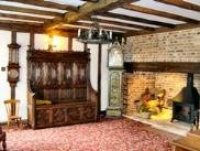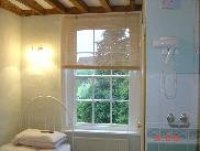Closed Until further Notice
History of Hassenbrook Hall
History of Hassenbrook Hall


Hassenbrook hall was re-erected around the year 1450. Originally a heavy framed timber building 50' long and 20' wide. It's now disguised beneath a brick and plaster casing. It had no upstairs rooms and stood as an open hall, divided into apartments for both Humans, cattle, and Horses. Upper chambers were inserted about the time of Queen Elizabeth.
An original brick floor in the north east wing is still intact. The animals were kept here. The floor slopes about 7 inches for cleaning purposes. There is evidence of an internal window from the living quarters where they could monitor their animals. And an original hand made metal tie ring is still fixed into one of the stud beams.
Walled Gardens circa 1530.Constructed into the wall is the Southern Archway a fantastic example of traditional brickwork with evidence of the featured archway being hand carved in-situ. There are also several arched Niches in-built into the four sections of the Wall. These were originally for Bee-Keeps to encourage fertilisation for the orchard. Soot was found deposited in them indicating they were used at a later date for frost lamps distributing heat into the orchard area for preserving the fruit. The Garden is split level, and the raised area near the Arch was a Vegetables garden. The lower area just formal Garden.
A Water Well was discovered recently when building work was carried out. It is 10 feet deep to the water table. Also a few feet away is a large circular reservoir holding tank underground for the kitchen.
Mullbery Tree was planted in the reign of James 1st about 400 years ago. He influenced all farmers Etc, to plant them for the Silk worm that was attracted to the white Berries Leaf. Ours didn't comply it is a red berry. Makes nice Wine though?
Cottage,Barns,Greenhouse,Fruitshed,were removed for re-development by Federated Homes in 1970.
Sliding Window that is dated 1688 was saved. installed originaly from an improvement by the Baronet and is displayed in Grays Museum.It is also believed an early Bamboo window taken from the Cottage is also there .The name window was taken from this early type which was constructed of bamboo's joining together leaving a hole in the middle.....Wind-Hole?
Ancient Name: Other than churches or Castles there are no Buildings in Essex which survive from the Norman period. But we can be quite certain that the present 'Hassenbrook Hall' stands upon the same farmstead site which had been occupied by the Saxon 'Leofstan' and his successor turold the Norman. Selected as a dry ground edging a stream, the freshwater Hassenbrook rivulet which gave it's name to the Manor. And which had it's own origin in the early Saxon language meaning the brook where 'Hassas' people settled. 'Hassa' himself was either Dutch or a German Migrant Leader during the 5th or 6th century A.D.The Manor name therefore survives from around 1,500 years ago.
The story of 'Hassenbrook Hall' reaches back for nearly a thousand years. Shortly before the conquest of England by the Norman Duke William in 1066. lands which comprised the manor of 'Hasingebroc' had been partly in the possession of a Saxon freeman called Leofstan.In 1086 the Saxon smallholding was given to his half Brother Odo Bishop of Bayeux.This royal Bishop was depicted in chain Armour @ the battle of Hastings upon the bayeux tapestry.( Having a portrait of a lord of Hassenbrook for so distant a time is remarkable.)
Lord's of the Manor of 'Hasingebroc' & Hassenbrook Hall Holders: Most Information is supplied by Mr.Randel Bingley from Domesday book and Church records.He was appointed the boroughs 1st curator at Thurrock History Society in 1975, which was founded in 1952.
Earls of Pembroke...........
William-de-Montchensy:..............circa 1257
Baron Robert-de-Vere:..................circa 1299
Baron Aymer-de-Valencee circa... 1308-1320
Sir Richard Talbott:.......................1376-1396
Reginald-de-Gray of Ruthin......... circa 1421
John Rede:...................................circa 1444
A Lord Mayor of London............
William Wetenhale :1457-1468 .Alderman of the City of London.Continued in the family until 1554.
Sir Richard Champion circa:1554-1568. Sheriff of London in 1530 and Lord Mayor of London in 1565 obtaining his Knighthood in the same year from Queen Elizabeth 1st. Passing it on to his nephew Richard in 1568 It was thought that he created the gabled house and Elizabethan walled gardens, but it now seems it was earlier after the analysis by Bulmar brick and Tile company who have since dated the bricks at 1530. Monuments to both Richards are In St Margaret's Church also displaying family's coat of Arms.
The Fe(a)therston(haugh)Family. Spelt 3 ways reside at 'Hassenbrook Hall' now for 180 years.
A true Royalist.......................................................
Cuthbert Fetherston 1607-1615.When Queen Elizabeth died in 1603 the Scottish James stewart fetched his court to London. Amongst them was Cuthbert Featherstone. He became the Kings usher and cryer.
Henry fetherston..... 1615-1648.
Sir Heneage Fetherston1648-1711.A staunch Royalist supporter through the civil war that was raging. Created Baronet of Blakesware and became Sheriff of Essex in 1666.
Sir Henry Fetherston 1711-1747.Said to be the richest man in the country. Outsurviving all his children at the age of 90 leaving his vast fortune to a relative from Northumberland.
Matthew Featherstonhaugh 1747-1774. acquired his Baronetcy with his new found wealth and purchased 'Uppark' in Sussex (now owned by National Trust)where he resided though he remained lord of 'Hassenbrook'. And is buried in St.Margaret's church Stanford-le-Hope.
Sir Harry featherstonhaugh 1774-1787 inherited the estates, Abbotts Hall,Waltons Hall,and Hassenbrook Hall at the age of 20. He took a 15 year old mistress by the name of Amy Lyon but disregarded her when she became pregnant. She then married Sir William Hamilton and became 'Lady Emma Hamilton' eternally linked in history with a certain' Lord Nelson'
Note: Many of the Fetherston family emigrated abroad to America, Australia etc, and also closer to home in Ireland. In particular the beautiful village of 'Ardagh' County Longford.
Charles Moore 1787-1790 son of the Archbishop of Canterbury
Lord James Scratton of Snaresbrook 1790. remained lord of Hassenbrook until his death at 86 the first year of Victoria's reign.
John Blyth 1851-1877. Founder of blyth and squires Brewery.
Thomas Worin Blyth. 1887-1902.
Farmer Guy Squire. 1902-1957
Farmers Ken & Doris Benton.1957-1970. moved to Arden Hall in Horndon-on-the-hill after selling Hassenbrook Hall for re-development. Because by then the Farm was becoming redundant after becoming isolated from most of it's Farmland's with the A.13 and the Railway cutting it off .
Federated Homes 1970-1978. Lost in Court to Chelmsford County Council for the demise of 'Hassenbrook hall'. An injunction was enforced for it's survival and it became a listed building. But they still developed all remaining Farmland left this side of the A.13.for Housing.
Mr.&Mrs.PTregunno 1978-2008. (Current) Respecting Historic Buildings have removed all the modern plaster-board from walls & ceilings that Federated Homes installed.Giving back the character by exposing the oak studwork and ceiling beam's that were hidden from both ground, and 1st floor level. Internal painted Brickwork in the animals quarters have been cleaned and repaired along with original Oak Beams, and Studwork, including two original oak windows. Repair work has also been started on the Southern Archway to maintain this splendid feature which is now dated (1530) by specialists from Sudbury, 'Bulmer brick and Tile company'. A suspect fire occurred when Federated Homes owned the property and it destroyed a large amount of oak from the Kitchen and front Hall. A large inglenook fireplace has been exposed and repaired in the front hall, and an original brick hearth was found buried and re-laid. In 1970 workmen were seen burning 17th century painted pine that went unrecognised by them which was installed on the first floor in. Recent work uncovered a brick chamber under the floor in an outhouse near the Animals quarters. This was a meter deep with a brick arch opening facing the brook about 35mtrs away. This suggests the Building was used as an toilet years ago and the opening probably continued into a trench and the contents away into the brook.